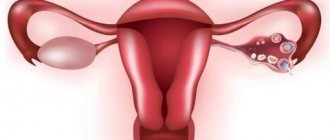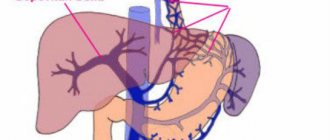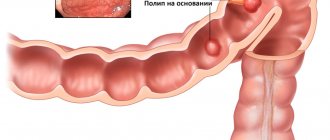Vascular dementia is an organic lesion of the brain. As a result of the pathological condition, a gradual defeat of higher mental functions occurs. As vascular dementia progresses, a person’s professional and social maladaptation develops. According to statistics, vascular dementia ranks second among all brain lesions accompanied by cognitive impairment. In the international classification of diseases, vascular dementia is coded F01. Depending on the location and etiological factor, the following are distinguished:
- F01.0 - dementia with acute onset;
- F01.1 - multi-infarction;
- F01.2 - subcortical;
- F01.3 - mixed;
- F01.8 - other;
- F01.9 - unspecified.
At the Yusupov Hospital you can undergo examination and receive quality treatment for vascular dementia. Consultations are conducted by experienced neurologists, psychotherapists, cardiologists and therapists. Thanks to modern medical equipment, it is possible to detect changes even in the early stages. This allows for timely treatment and a complete recovery.
Causes of vascular dementia
One of the main reasons for the development of vascular dementia is the death of brain cells due to impaired blood microcirculation. This may be circulatory failure or complete cessation of blood flow. The causes of this condition are:
- traumatic brain injuries;
- acute cerebrovascular accident of various origins;
- vascular atherosclerosis;
- thromboembolism;
- arterial hypertension;
- inflammatory vascular diseases;
- rupture of the vascular wall.
Doctors identify predisposing factors, the presence of which increases the risk of developing vascular dementia. These include:
- smoking;
- alcohol abuse;
- age over 65 years;
- diabetes mellitus of any kind;
- family history of mental illness.
Expert opinion
Author: Andrey Igorevich Volkov
Neurologist, Candidate of Medical Sciences
Vascular dementia is a very insidious condition, especially if it develops gradually. Memory disappears, thinking becomes more limited, emotional lability appears - it becomes difficult to maintain communication with a person. Many people attribute everything to age or irreparable consequences of injuries. But through proper treatment, this condition can be alleviated, and in some cases, even regression can be achieved.
When a patient comes to our clinic, we first conduct a full examination (CT, MRI, EEG) to assess his condition and select therapy. As a rule, it includes several groups of drugs: thrombolytics, acetylcholinesterase inhibitors, vasoactive drugs, nootropics. In especially severe cases, after consultation with a vascular surgeon, surgical intervention is performed.
Dementia cannot be cured, but modern drugs can effectively stop the consequences and prevent tissue degradation. Drug treatment and work with a psychotherapist give good results - the patient’s general condition improves and cognitive functions are restored.
It is incorrect to think that dementia is simply a decline in memory and cognitive abilities. These are the most severe consequences and, first of all, a decrease in the quality of life.
Dementia
Alzheimer's type dementia
Alzheimer's disease was described in 1906 by the German psychiatrist Alois Alzheimer.
Until 1977, this diagnosis was made only in cases of dementia praecox (aged 45-65 years), and when symptoms appeared after the age of 65 years, senile dementia was diagnosed. It was then found that the pathogenesis and clinical manifestations of the disease are the same regardless of age. Currently, the diagnosis of Alzheimer's disease is made regardless of the time of appearance of the first clinical signs of acquired dementia. Risk factors include age, having relatives with this disease, atherosclerosis, hypertension, excess weight, diabetes mellitus, low physical activity, chronic hypoxia, traumatic brain injury and lack of mental activity throughout life. Women get sick more often than men. The first symptom is a pronounced impairment of short-term memory while maintaining criticism of one’s own condition. Subsequently, memory disorders worsen, and a “movement back in time” is observed - the patient first forgets recent events, then what happened in the past. The patient ceases to recognize his children, mistakes them for long-dead relatives, does not know what he did this morning, but can talk in detail about the events of his childhood, as if they had happened quite recently. Confabulations may occur in place of lost memories. Criticism of one's condition decreases.
In the advanced stage of Alzheimer's disease, the clinical picture is complemented by emotional and volitional disorders. Patients become grouchy and quarrelsome, often demonstrate dissatisfaction with the words and actions of others, and become irritated by every little thing. Subsequently, delirium of damage may occur. Patients claim that loved ones deliberately leave them in dangerous situations, add poison to their food in order to poison them and take over the apartment, say nasty things about them in order to ruin their reputation and leave them without public protection, etc. Not only family members are involved in the delusional system, but also neighbors, social workers and other people interacting with patients. Other behavioral disorders may also be detected: vagrancy, intemperance and indiscriminateness in food and sex, senseless disorderly actions (for example, shifting objects from place to place). Speech becomes simplified and impoverished, paraphasia occurs (the use of other words instead of forgotten ones).
At the final stage of Alzheimer's disease, delusions and behavioral disorders are leveled out due to a pronounced decrease in intelligence. Patients become passive and inactive. The need to take fluids and food disappears. Speech is almost completely lost. As the disease worsens, the ability to chew food and walk independently is gradually lost. Due to complete helplessness, patients require constant professional care. Death occurs as a result of typical complications (pneumonia, bedsores, etc.) or progression of concomitant somatic pathology.
The diagnosis of Alzheimer's disease is made based on clinical symptoms. Treatment is symptomatic. There are currently no drugs or non-drug treatments that can cure patients with Alzheimer's disease. Dementia progresses steadily and ends with complete collapse of mental functions. The average life expectancy after diagnosis is less than 7 years. The earlier the first symptoms appear, the faster the dementia worsens.
Vascular dementia
There are two types of vascular dementia - those that arose after a stroke and those that developed as a result of chronic insufficiency of blood supply to the brain. In post-stroke acquired dementia, the clinical picture is usually dominated by focal disorders (speech disorders, paresis and paralysis). The nature of neurological disorders depends on the location and size of the hemorrhage or area with impaired blood supply, the quality of treatment in the first hours after a stroke and some other factors. In chronic circulatory disorders, symptoms of dementia predominate, and neurological symptoms are quite monotonous and less pronounced.
Most often, vascular dementia occurs with atherosclerosis and hypertension, less often with severe diabetes mellitus and some rheumatic diseases, and even less often with embolism and thrombosis due to skeletal injuries, increased blood clotting and peripheral venous diseases. The likelihood of developing acquired dementia increases with diseases of the cardiovascular system, smoking and excess weight.
The first sign of the disease is difficulty trying to concentrate, distracted attention, fatigue, some rigidity of mental activity, difficulty planning and decreased ability to analyze. Memory disorders are less severe than in Alzheimer's disease. Some forgetfulness is noted, but when given a “push” in the form of a leading question or offered several answer options, the patient easily recalls the necessary information. Many patients exhibit emotional instability, low mood, depression and subdepression are possible.
Neurological disorders include dysarthria, dysphonia, gait changes (shuffling, decreased step length, “sticking” of the soles to the surface), slowing of movements, impoverishment of gestures and facial expressions. The diagnosis is made on the basis of the clinical picture, ultrasound and MRA of cerebral vessels and other studies. To assess the severity of the underlying pathology and draw up a pathogenetic therapy regimen, patients are referred for consultation to the appropriate specialists: therapist, endocrinologist, cardiologist, phlebologist. Treatment is symptomatic therapy, therapy of the underlying disease. The rate of development of dementia is determined by the characteristics of the leading pathology.
Alcoholic dementia
The cause of alcoholic dementia is long-term (over 15 years or more) abuse of alcoholic beverages. Along with the direct destructive effect of alcohol on brain cells, the development of dementia is caused by disruption of the activity of various organs and systems, severe metabolic disorders and vascular pathology. Alcoholic dementia is characterized by typical personality changes (coarsening, loss of moral values, social degradation) combined with a total decrease in mental abilities (distracted attention, decreased ability to analyze, plan and abstract thinking, memory disorders).
After complete cessation of alcohol and treatment of alcoholism, partial recovery is possible, however, such cases are very rare. Due to a pronounced pathological craving for alcoholic beverages, decreased volitional qualities and lack of motivation, most patients are unable to stop taking ethanol-containing liquids. The prognosis is unfavorable; the cause of death is usually somatic diseases caused by alcohol consumption. Often such patients die as a result of criminal incidents or accidents.
Symptoms of vascular dementia
The severity of clinical symptoms of vascular dementia depends on the severity of the condition. The initial stages of the disease may be asymptomatic. This makes it difficult to diagnose the disease in a timely manner. In addition, the rate of progression of dementia depends on etiological factors. Doctors identify the following clinical symptoms, the presence of which indicates the development of the disease:
- gradual memory loss. In the beginning, events that happened recently are forgotten. As the pathology progresses, amnesia also affects long-term memory;
- emotional lability. The severity of the symptom depends on the stage. Severe vascular dementia may be accompanied by aggression, mistrust, and tearfulness. These symptoms are abruptly replaced by apathy;
- narrowing the range of interests. Due to speech and thought disorders, patients drop out of social life and become isolated;
- changes in speech and writing. Handwriting becomes illegible and choppy. Speech is dominated by simple phrases and frequent repetitions;
- difficulties in perceiving new information. In this regard, the ability to perform work duties is gradually lost;
- gait changes. As vascular dementia progresses, instability develops. As a result, the gait becomes undulating and patients sway from side to side.
- attacks of depression and psychosis.
The severe stage of vascular dementia requires constant outside care. Patients are unable to perform simple actions and the ability to self-care is completely lost.
General groups of symptoms
The disease distinguishes two groups of disorders: cognitive and neurological.
Cognitive disorders come to the fore, that is, regression of cognitive and thinking functions.
At the initial stage of the disease, memory is primarily affected. At first these are subtle changes. A person forgets some events, individual names and dates, and cannot find the right word to express a thought. The process of assimilation of new knowledge worsens, and it becomes increasingly difficult for the patient to remember and analyze new information.
Gradually, amnestic symptoms increase. The person does not grasp the meaning of what was said, and it becomes more and more difficult to find words. Because of this, his speech becomes meager, his sentences are short and monosyllabic. If talkativeness manifests itself, then it is incoherent; letters in words can be rearranged, words can be replaced. The person himself does not understand the meaning of what he said. Speech impairment leads to difficulties with writing and reading.
Amnesia occurs in the following forms:
- progressive - the patient begins to forget what happened to him recently, and then earlier events;
- fixation – inability to perceive, analyze, store new material, current events. Consciousness in such patients is preserved; they remember well the events of the past, but cannot remember what they talked about with the person 5 minutes ago. Having bought milk, brought it home and put it in the refrigerator, a few minutes later they are going to the store again to buy it, since they have already forgotten that they purchased it;
- Paramnesia is false memories when the patient supplements reality with unreal events. For example, he may pass off as reality events read in a book or seen in a film, and believe that this actually happened to him. Or he simply fantasizes, passing off as reality what did not happen. It is possible that events may shift in time, that is, what happened many years ago is perceived by a person as having happened yesterday.
In addition to memory, other cognitive functions are affected in vascular dementia. Attention is scattered, it is impossible to fix it for a long time. Perception is disrupted. Thinking becomes inflexible. It is difficult to switch from one activity to another.
Often, as the process progresses, patients develop a symptom such as Korsakoff's syndrome, named after the doctor who first described it. It combines several symptoms. First of all, this is fixation amnesia. As already mentioned, the patient does not remember current events, but retains memory of the past. In this regard, he loses orientation in time and space. So-called amnestic disorientation develops.
There are also various variations of paramnesia: doubts about the occurrence of a particular event, their displacement in time, a mixture of fictional and true events.
Against this background, a person gets lost in an unfamiliar environment. He doesn't understand where he is. While in the hospital, he cannot find his bed, but in a familiar environment, at home, he finds his way around perfectly.
Stages of development of vascular dementia
During vascular dementia there are 3 stages:
- early. Characterized by the gradual development of clinical signs. Initial complaints may include decreased concentration, memory loss, increased fatigue, and difficulty in perceiving new information. In some cases, speech impairment develops. Patients use simple phrases when speaking and have difficulty understanding complex phrases. Early treatment can lead to complete recovery. The difficulty lies in the timely diagnosis of the pathological condition;
- average. As the pathological condition progresses, clinical symptoms become more pronounced. Patients forget recent events and the names of ordinary objects. At the middle stage of vascular dementia, work becomes impossible. Pathological changes lead to disruption of communication with others. Patients drop out of social life and become isolated. Speech becomes as simple as possible, the same phrases are often heard;
- late. Requires outside nursing due to the development of motor and severe mental disorders. The late stage of vascular dementia is characterized by memory impairment up to agnosia. Patients are disoriented in space and time, they lose motivation to perform habitual actions. Criticism of one's own condition is completely absent. In some cases, patients may leave home.
Depending on the severity of cognitive impairment, the following degrees of dementia severity are distinguished:
- light. The disorders are almost invisible to others. Their presence is felt only by the patient. Immediate events begin to be poorly remembered. At the same time, professional skills are retained in full. A mild degree of cognitive impairment can be determined by the slow pace of completion of neuropsychological tasks;
- moderate. The causes of this disorder vary and are not always related to age. The severity of symptoms becomes noticeable not only to patients, but also to their loved ones. Neuropsychological tests are also performed at a slow pace;
- heavy. Impairments in cognitive functions at this stage become irreversible. A severe degree of vascular dementia indicates the presence of structural changes in the nervous system. The prognosis for recovery becomes unfavorable.
Symptoms
As a rule, “vascular dementia” is diagnosed if cognitive impairment was preceded by a stroke. Quite often, accompanying signs are symptoms of focal brain damage, for example, manifestations of hemiparesis (weakness of the muscles of one side, anisoreflexia, pathological foot signs, etc.). A characteristic symptom is a walking disorder - a slow, shuffling gait and instability (which patients themselves often call dizziness).
As mentioned above, the cause of vascular dementia lies in circulatory disorders in the brain. The potential for disturbances to occur exists in different areas of the brain. Therefore, the external manifestations of vascular type dementia differ significantly in each case. Let's list the most typical ones.
Dementia caused by damage to the midbrain is manifested by mesencephalothalamic syndrome. The first manifestations are confusion and hallucinations. A person becomes apathetic, withdraws into himself, does not care about his appearance, and neglects personal hygiene. His psychophysiological state is usually characterized by increased drowsiness. In some cases there are speech disorders.
In dementia caused by damage to the hippocampus, first of all, there is an impairment in the ability of memory to retain information about current events (long-term memory can be retained).
As a result of a stroke, apathetic-abulsic syndrome is observed in the prefrontal regions of the frontal lobes. The patient behaves inappropriately, there is no criticism of the condition. Inadequacy consists in repeated repetition of one’s own words and actions, or the words and actions of others.
Subcortical lesions lead to disruption, first of all, of daily activities: it is difficult for the patient to concentrate on one subject and maintain one type of activity; problems arise with making plans. There is also a violation of the skills of information analysis (separation of the main from the secondary).
A stable sign of vascular dementia is impaired urination; it is observed in almost all persons suffering from dementia.
Symptoms of vascular dementia are also noticeable in the psycho-emotional sphere. There is a general decrease in mood and self-esteem, emotional instability, depression appear, and self-confidence is lost.
Diagnosis of vascular dementia
Vascular dementia requires a comprehensive diagnosis. In addition to a physical examination and questioning of the patient, instrumental studies are prescribed. The necessary diagnostic measures include:
- EEG - records changes occurring in brain activity;
- CT, MRI - allow you to establish the localization of the pathological focus;
- Ultrasound of the great vessels - assesses the degree of patency of the brain vessels and diagnoses stenosis;
- PET-CT is the most informative method for identifying pathological foci in the brain using a radioisotope contrast agent.
Vascular dementia requires differential diagnosis with Alzheimer's disease. At the Yusupov Hospital, research is carried out using modern medical equipment manufactured in Europe and the USA. This makes it possible to establish the causes of vascular dementia in the shortest possible time. The timeliness of the therapy started and the effectiveness of the treatment depend on the speed and quality of diagnosis.
Diagnostics
- Similar to diagnosis for other forms of dementia
- Neurotomography
Diagnosis of vascular dementia is similar to diagnosis of other types of dementia. To make a general diagnosis of dementia, all of the following criteria must be present:
- Cognitive or behavioral (neuropsychiatric) symptoms affect the ability to function at work or perform normal daily activities.
- These symptoms represent a clear decline from previous levels of functioning.
- These symptoms are not explained by the presence of delirium or a major mental disorder.
The assessment of cognitive impairment includes a history from both the patient and his acquaintances, plus a so-called bedside mental status examination or, if the results are equivocal, formal neuropsychological tests.
Differentiation of vascular dementia from other forms of dementia is based on clinical assessment. Factors that suggest vascular dementia (or Alzheimer's disease with cerebrovascular disease) include the following:
- Signs of cerebral infarctions
- High score on the Khachinsky Ischemia Rating Scale
- Clinical features consistent with vascular dementia (eg, marked decline in executive function with mild or absent memory loss)
Confirmation of vascular dementia is a history of stroke or evidence of a vascular cause of dementia detected by neuroimaging. If there are focal neurological symptoms or signs of cerebrovascular disease, a thorough examination is necessary to exclude stroke.
- CT and MRI can reveal
- Bilateral multiple infarcts in the dominant hemisphere and limbic structures
- Multiple lacunar strokes
- Periventricular white matter lesions extending into the white matter
- In Binswanger's disease, leukoencephalopathy in the area of the centrum semiovale adjacent to the cortex, often with the presence of lacunae extending to the gray matter structures in the deep parts of the cerebral hemispheres (including the basal ganglia, thalamus)
In the differential diagnosis of vascular dementia and Alzheimer's disease, the use of the Hachinsky ischemic scale (Modified Hachinsky Ischemia Rating Scale) may be useful.
Treatment of vascular dementia
The main goals of therapy for vascular dementia are:
- prevention of further deterioration of the condition;
- improving the quality of life of patients.
If there are concomitant somatic diseases that may cause the development of vascular dementia, they are corrected. To stabilize blood pressure, antihypertensive therapy is prescribed. Further treatment of vascular dementia includes:
- normalization of parameters of the hemostatic system. In this way, it is possible to reduce the risk of developing blood clots and recurrent strokes. For this purpose, anticoagulants, antiplatelet agents, and thrombolytics are prescribed. Patients are advised to quit smoking and follow the principles of a rational and balanced diet;
- activation of the central nervous system and intellectual abilities. For this purpose, acetylcholinesterase inhibitors are used;
- carrying out sedative therapy. Nootropics have a direct activating effect on brain activity. Sedative therapy protects brain structures from various damages. In addition, the treatment helps to launch metabolic processes in nerve cells;
- dilation of blood vessels in the brain and heart. This is necessary to ensure blood flow to the listed organs. For this purpose, vasoactive drugs are prescribed;
- symptomatic therapy. It is carried out depending on the existing clinical signs.
Surgical intervention may be necessary if there is more than 70% stenosis of the lumen of the vessels of the head by atherosclerotic plaques. The need for surgery is discussed with a vascular surgeon.
At the Yusupov Hospital, experienced neurologists, therapists, cardiologists and psychiatrists treat dementia. An individual treatment plan is developed for each patient. The drugs used meet quality and safety standards, and are also included in the list of the latest European recommendations for the treatment of vascular dementia.
Classification by localization
- Cortical dementia - formation occurs with predominant damage to the cerebral cortex. Examples are Alzheimer's disease and alcoholic encephalopathy. This type is characterized by amnesia, significant cognitive disorders, such as impairment of abstract thinking and calculation, speech disorders, even absence, and inability to recognize faces. The patient does not remember his name and does not recognize his relatives. Movement disorders are not typical.
- Subcortical dementia is a disease that affects subcortical structures. Examples are: dementia in Parkinson's disease, Huntington's disease, toxic dementia, as well as dementia in diseases such as normal pressure hydrocephalus, metabolic encephalopathy, corticobasal degeneration. The disease is characterized by slow thinking, nasal or muffled speech, mild memory impairment - forgetfulness, severe motor impairment, and tremor.
- Cortical-subcortical dementia is formed when the cortex and subcortical structures are damaged, with the presence of two types of symptoms. Typical representatives are: vascular dementia, dementia with Lewy bodies, corticobasal degeneration.
- Multifocal dementia is a rapidly progressing type; the disease is characterized by multiple focal lesions in all parts of the brain. An example is Creutzfeldt-Jakob disease. Characterized by amnesia, perceptual disturbances, speech impairment and loss of practical skills.
Complications of vascular dementia
Complications of vascular dementia occur against the background of a severe course of the disease. Among them are:
- loss of labor and social adaptation;
- septic complications due to impaired motor activity;
- injuries due to instability;
- irregular use of prescribed medications;
- sleep-wake disturbance;
- lack of personal hygiene;
- poor nutrition.
Severe vascular dementia leads to worsening concomitant diseases. Therefore, at this stage, patients require constant care.
Forecast
At the present stage of development of medicine, the prognosis for recovery for any type of dementia is unfavorable. Dementia is considered to be an irreversible condition. There is also an unfavorable prognosis for work ability (a patient with dementia is a priori disabled), a relatively unfavorable prognosis for life, but vascular dementia itself is not the cause of the patient’s death.
Death often occurs due to cancer, acute vascular accident, and infectious lesions (especially important among which are diseases of the genitourinary tract due to poor hygiene in patients with dementia).
Prevention of vascular dementia
The initial stages of vascular dementia are rarely amenable to timely diagnosis. This is due to the absence of specific symptoms in the early stages. Therefore, doctors advise following preventive recommendations to prevent the development of vascular dementia. These include:
- normalization of blood pressure. Uncontrolled hypertension negatively affects the condition of blood vessels. To maintain blood pressure within normal limits, doctors prescribe special treatment. Independent selection of medications is excluded;
- active lifestyle. Walking in the fresh air and adequate physical activity have a positive effect on the state of the cardiovascular system. As a result, the blood is saturated with oxygen, and the capabilities of the myocardial muscles increase. However, the loads should not be excessive. Otherwise, the condition may worsen sharply;
- limitation of psycho-emotional experiences. To stabilize the emotional background, regular walks in the fresh air, classes with a psychologist or attending specialized trainings are recommended;
- quitting smoking and drinking alcohol. Chronic intoxication negatively affects not only the condition of blood vessels, but also the entire body;
- rational and balanced nutrition. The daily menu should contain a sufficient amount of fresh vegetables, fruits, herbs and fiber. Excessive amounts of fatty and fried foods should be excluded from the diet;
- control of sex hormone levels. This recommendation is especially relevant for women.
Vascular dementia can be diagnosed and treated at the Yusupov Hospital. The clinic has the latest equipment, which allows us to detect changes even at the initial stages. Treatment is carried out according to the latest European recommendations. The drugs used meet the quality and safety requirements. You can make an appointment by phone.
Treatment
- Safety precautions and supportive care
- Management of vascular risk factors, including smoking cessation
Safety measures and supportive care are similar to those for other forms of dementia. For example, the environment should be bright, fun and familiar, and should be aimed at reinforcing orientation (eg, placing large clocks and calendars in the room). Patient safety measures (eg alarm monitoring systems for patients who may become lost) should be implemented.
Troubling symptoms can be treated.
Management of vascular risk factors (eg, hypertension, diabetes, hyperlipidemia) may slow the progression of vascular dementia and help prevent future strokes, which may lead to worsening cognitive impairment. Treatment includes the following:
- Blood pressure control
- Cholesterol-lowering therapy
- Regulation of plasma glucose (90 to 150 mg/dL)
- To give up smoking
Drugs such as cholinesterase inhibitors and memantine may be helpful if you have Alzheimer's disease. The use of cholinesterase inhibitors may improve cognitive function. The use of the NMDA receptor antagonist (N-methyl-D-aspartate), memantine, may slow the loss of cognitive function in patients with moderate to severe dementia and may be synergistic with the use of cholinesterase inhibitors.
However, the effectiveness of cholinesterase inhibitors and memantine in vascular dementia has not been established. However, the use of these drugs makes sense because older patients with vascular dementia may also have Alzheimer's disease.
Basic provisions
- Vascular dementia can occur as a series of discrete episodes (which may initially begin as gradual deterioration) or as a single episode.
- Focal neurological symptoms can help differentiate vascular dementia from other types of dementia.
- Will confirm that dementia is vascular based on history of stroke or neuroimaging findings that suggest a vascular cause.
- Vascular risk factors must be monitored, and if Alzheimer's disease may also be present, treatment with cholinesterase inhibitors and memantine is recommended.
Authors: Juebin Huang, MD, PhD, Memory Impairment and Neurodegenerative Dementia (MIND) Center, University of Mississippi Medical Center Last full review/revision March 2021 by Juebin Huang, MD, PhD
Treatment and care
In the modern world, numerous drugs are being studied in various stages of clinical trials for the treatment of dementia. Unfortunately, there is currently no therapy to cure or change the course of the disease. Comprehensive treatment of dementia is aimed at stabilizing the process and reducing the severity of existing symptoms. Treatment should be carried out for hypertension, atherosclerosis, diabetes mellitus, obesity - diseases that aggravate dementia. Much can be done to support and improve the lives of people with the condition and their carers.
The main goals of medical care for dementia are: whenever possible, early diagnosis and prevention of the development of the disease; as well as measures to optimize the patient’s physical health, activity, and maintenance of mental perception processes. It is necessary to identify, treat and correct comorbidities, behavioral and psychological symptoms. Provide information and long-term support to carers.
Clinical course and prognosis
The clinical course and prognosis of the disease is influenced by the cause that caused pathological changes in the central nervous system. For example, in post-traumatic dementia, when the underlying disease is not prone to development, with adequate treatment, significant improvements are possible as a result of developing compensatory reactions. When other, unaffected areas of the cerebral cortex will be able to take over some of the functions. Alzheimer's disease and vascular dementia are among the most common types of steadily progressive dementia. Treatment of these diseases is only the removal of unpleasant symptoms, slowing down the disease process, social and personal adaptation of patients, and prolonging their life. With a rapidly progressing disease that causes dementia, the prognosis is unfavorable. The patient dies several years, sometimes months, after the first symptoms of the disease appear. Death is usually caused by concomitant diseases, such as pneumonia, sepsis, which develop against the background of damage to the central regulation of human systems and organs.
Forms of dementia
- Lacunar form of dementia
It is characterized by peculiar isolated lesions of the structures responsible for intellectual activity. The most pronounced symptom is dysmensia - a violation of short-term memory. Dysmnestic dementia. Maintaining a critical attitude towards your condition. Symptoms of emotional lability, tearfulness, hypersensitivity. A typical example of lacunar dementia is the initial stage of Alzheimer's disease.
- Total form of dementia
The frontal lobes of the cerebral cortex are affected; the cause of the damage may be vascular disorders, atrophic (with Pick's disease) and volumetric processes: hematomas, tumor formations, abscesses. The total form of dementia is characterized by personality disintegration with the presence of gross changes in emotional and volitional activity, complete devaluation of spiritual values, loss of vital interests, with the disappearance of a sense of duty and modesty. The person experiences total dementia and complete social maladjustment.
General information about the disease
The most common type of disease is senile (senile) dementia. Develops in people of the older age group (after 60 years). It is an aggravated form of natural degradation of brain neurons, most often accompanied by other diseases, including Alzheimer's disease, AIDS, encephalitis, and infectious meningitis.
Dementia in the elderly is incurable. The therapy offered today is aimed only at alleviating the condition of patients, as well as slowing down the process of degradation of cognitive functions. That is, it is necessary to understand that the patient’s condition will gradually worsen to the point that he will require constant round-the-clock care.
Disease prevention
Preventive measures are aimed at combating risk factors for the development of diseases in adulthood and old age, such as: depression, vascular diseases, hypertension, atherosclerosis, diabetes, obesity, high cholesterol.
It is necessary to eliminate bad habits such as smoking and alcohol abuse, which can trigger the development of early dementia.
Physical education reduces the risk of developing dementia and slows it down, allowing you to maintain skills that are necessary in everyday life, and helps improve the cognitive abilities of people with dementia.
Nutrition helps prevent dementia. Research confirms the fact that the more vegetables and fruits in a person’s diet at a young age, the lower the percentage of developing dementia in the future.
Early dementia is usually difficult to diagnose. Symptoms such as absent-mindedness, forgetfulness, and inability to concentrate can be explained by chronic fatigue and stress, so it is very important to see a doctor if your cognitive abilities are deteriorating.








